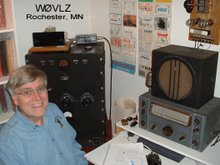 I finally got the relay box finished so that I can use my grounded grid 572B amplifier with my KX3. On receive it bypasses the amplifier and delivers -100VDC cutoff bias. On transmit the 572B grid is grounded and the KX3 output is routed through the amplifier.
I finally got the relay box finished so that I can use my grounded grid 572B amplifier with my KX3. On receive it bypasses the amplifier and delivers -100VDC cutoff bias. On transmit the 572B grid is grounded and the KX3 output is routed through the amplifier.Lacking a triple pole-double throw relay I used a double pole-double throw relay to transfer the antenna and a single pole-double throw relay to switch the cutoff grid bias. The two relays run off of 12 VDC but together require about 1/2 amp, way more than the KX3 Keyline Out line can handle. A "Keyall" board from Jackson Harbor Press/WB9KZY solved that problem. Ideally I would have used a single transformer that delivered 12VAC and 100VAC for the two supplies. Lacking the ideal I used back to back 12V transformers. One toggle switch was added to allow manual send/receive control without the Keyline Out signal from my KX3. Another toggle switch was needed to power on/off the 12V/100V power supply.
When I use the relay box and my amp, the KX3 antenna tuner has to stay in the circuit in order to match the transceiver to the uncontrolled input impedance of the amplifier. In addition the antenna relay can not follow break-in CW keying without losing the first dit so I must use the KX3 in PTT mode. On the plus side I run about 80 watts to the antenna instead of 4, maybe not a big deal for CW but real help for SSB.

















